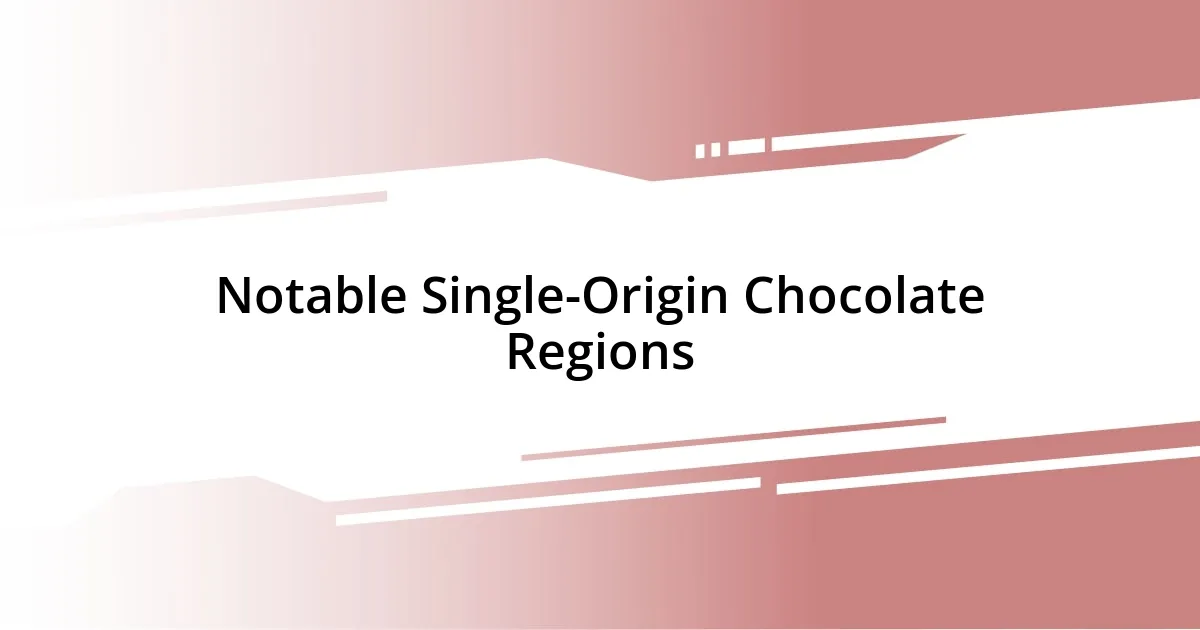Key takeaways:
- Single-origin chocolate showcases unique flavors that reflect the specific region or estate of cacao, offering a sensory journey through diverse cultures and histories.
- It promotes sustainability and ethical practices, often supporting fair trade and environmentally-friendly methods in cacao production.
- Tasting chocolate mindfully enhances the experience, revealing complexities in flavors and textures that connect the eater to the cacao’s journey and artisanal craftsmanship.
- Pairing single-origin chocolate with complementary or contrasting foods can elevate the tasting experience and highlight the chocolate’s distinct flavor profiles.

What is Single-Origin Chocolate
Single-origin chocolate is crafted from cacao beans sourced from a specific region or even a single estate, which gives it distinct flavors that reflect the local terroir. When I first tasted a bar from Venezuela, I was amazed at how the notes of red fruit danced alongside the rich cocoa, something I’d never experienced in blends. Isn’t it fascinating how the geography influences the taste, much like how a fine wine tells a story of its vineyard?
The purity of single-origin chocolate means that each bite is a mini adventure, a glimpse into the heritage and culture of the location where the beans are grown. I recall a moment where dark chocolate from Madagascar opened up flavors of citrus and spice, and I wondered, how could something so simple evoke such complexity? It’s these unique characteristics that make each chocolate bar feel like a piece of artistry that’s meant to be savored.
In essence, single-origin chocolate isn’t just a treat; it’s an invitation to explore diverse regions through your palate. When I learned to distinguish the subtle differences in flavor profiles, it felt like uncovering hidden gems in a treasure hunt. Can you imagine the thrill of tasting chocolate that connects you directly to the land and its people?

Benefits of Single-Origin Chocolate
When I indulge in single-origin chocolate, I notice how it often promotes sustainability and ethical practices. Many producers are committed to fair trade and environmentally friendly methods. I once visited a small farm in Ecuador, where the farmers were not only passionate about their craft but also about preserving their land for future generations. It’s inspiring to know that my chocolate habit can support people who truly care about their environment and their communities.
Another remarkable benefit is the exceptional and varied flavor profiles that single-origin chocolate offers. Each region has its unique signature, shaped by the soil and climate. On a memorable tasting night with friends, we sampled bars from Colombia and Ghana side by side. The Colombian chocolate was berry-infused, while the Ghanaian offered a deep, earthy richness. It sparked a delightful discussion around our favorite flavors and how diverse cacao can be, reminding me that chocolate can be a social experience as much as a personal one.
Finally, single-origin chocolate encourages mindfulness and appreciation for craftsmanship. As I savor a piece, I find myself reflecting on the journey from bean to bar. During a recent chocolate tasting workshop, I learned to analyze the textures, aromas, and subtle notes in each bite. It turns the simple act of eating chocolate into a sensory exploration, igniting a profound respect for the artisans behind these creations. Who knew that each piece carried a story worth discovering?
| Aspect | Single-Origin Chocolate |
|---|---|
| Sustainability | Often supports ethical practices and fair trade |
| Flavor Diversity | Unique profiles influenced by region |
| Mindfulness | Encourages appreciation of craftsmanship |

How to Taste Chocolate
To truly appreciate chocolate, tasting it thoughtfully is key. I’ve learned that the experience enhances every flavor, making it memorable. Begin by letting the chocolate melt slowly in your mouth, allowing your taste buds to awaken. Pay attention to the textures, aromas, and flavors that unfold. It’s like watching a story develop, layer by layer.
Here’s how to go about tasting chocolate:
- Look: Observe the color and sheen. A glossy finish indicates quality.
- Smell: Inhale deeply. The aroma carries hints of what’s to come.
- Snap: Break a piece to listen for that satisfying sound; this indicates proper tempering.
- Melt: Place it on your tongue. Don’t rush—let it dissolve and reveal its complexities.
- Savor: Reflect on the flavors you discern—fruity, nutty, floral—and notice how they evolve.
In my own journey, I vividly recall savoring a bar from Tanzania. The initial notes were like biting into a ripe banana, followed by a surprising hint of spice. I was astonished at how each second brought out new sensations. Tasting chocolate is not merely an act—it’s an exploration that connects you to the cacao’s journey.

Understanding Flavor Profiles
When I first started exploring single-origin chocolate, I quickly realized how each bar tells a unique story through its flavor profile. For instance, I remember indulging in a Madagascan chocolate that burst with bright citrus notes, almost like tasting sunshine. It made me wonder how something so simple could evoke such powerful emotions just by invoking memories of fresh fruits.
Not every chocolate would resonate with me the same way, but that’s where the beauty lies in the diversity. During one tasting, I found myself grappling with a bar from Venezuela, which had intriguing hints of tobacco and spice. It left me questioning, how can something so unexpected be so enjoyable? Savoring that complexity was thrilling; it felt like embarking on a small adventure with each bite, discovering new layers of flavor that surprised me.
It’s fascinating how environment plays a substantial role in shaping these profiles. The terroir—essentially the conditions like soil composition and climate—significantly impacts the cacao’s taste. I believe it’s amazing that the same type of bean can yield vastly different flavors based on where it’s grown. When I paired chocolate from Papua New Guinea, with its deep, fruity undertones, alongside a bar from Peru, tinged with subtle floral notes, it was a vivid reminder of how our world offers varying experiences even in something as seemingly uniform as chocolate. Doesn’t that open up a whole new perspective on tasting?

Pairing Single-Origin Chocolate
Finding the right pairing for single-origin chocolate can elevate your tasting experience to new heights. I distinctly remember the time I combined a bold bar from Madagascar with a cup of rich Earl Grey tea. The citrusy notes of the chocolate danced beautifully with the bergamot in the tea, creating a harmonious balance that brought out the best in both. It made me ponder: how often do we overlook these delightful matches that can transform our palate?
Another unforgettable experience was pairing a dark chocolate from Ecuador, known for its earthy undertones, with a sharp blue cheese. The saltiness of the cheese complemented the chocolate’s richness, producing a gratifying interplay of flavors. I found myself asking, have you ever considered contrasting flavors in your pairings? This exploration led me to realize that opposites can indeed attract, striking a memorable chord in our taste buds.
Moreover, I discovered that the seasonality of certain foods also plays a vital role in pairing. During a summer picnic, fresh strawberries alongside a bar from Ghana, with its vibrant cocoa notes, created a refreshing contrast that tasted just like bliss. I couldn’t help but think, isn’t it fascinating how seasonal ingredients can enhance our chocolate experience? These pairings became tangible reminders of how food, much like life, is all about discovery and enjoyment.

Notable Single-Origin Chocolate Regions
One of the most intriguing regions for single-origin chocolate is Ecuador. During my exploration, I tasted a bar that transported me to the lush cacao farms in the Andean foothills. It was rich and complex, filled with earthy notes that seemed to whisper stories of the land. I couldn’t help but ask myself, how does the lush flora and diverse microclimates shape the beans into such a distinctive flavor?
The experience of tasting chocolates from Madagascar is unforgettable as well. I recall my first bite of a bar from this region and feeling an explosion of bright berry flavors coupled with that unique acidity. It was like sunshine on my palate! What struck me most was how even the color of the cacao pods reflected their vibrant taste, reminding me of the vibrant culture and energetic spirit of Madagascar itself.
I also ventured into the world of Peruvian chocolate, which I found nuanced and enchanting. A particular bar I indulged in carried hints of floral and fruity notes, reminiscent of the rich biodiversity found in the Amazon. It made me appreciate the traditional farming methods that carry forward centuries of craft. Isn’t it incredible how a single piece of chocolate can connect you to different cultures and histories, all through taste?

My Personal Tasting Experience
One of my most memorable tasting experiences occurred when I indulged in a bar from the Dominican Republic. The moment I placed it on my tongue, the rich, velvety texture enveloped my senses, and a burst of cocoa flavor lingered in the air. It reminded me of the serene afternoons spent in my grandmother’s kitchen, where the scent of homemade brownies mingled with laughter. Have you ever tasted something that brought back floods of memories?
I also recall the first time I savored a chocolate from Venezuela. It had a deep, almost mysterious flavor profile, with hints of dried fruit and spices warming each bite. As I experienced the complexity unfold, I couldn’t help but feel a connection to the land and the artisans who crafted it. It was like sipping a fine wine, where each layer revealed something new and unexpected. Isn’t it remarkable how chocolate can evoke such profound emotions?
Most recently, I explored single-origin chocolate from Bolivia. The tasting was a transformative experience, as the bright, fruity notes transported me to a sun-drenched field filled with cacao trees. In that moment, I felt grateful for the skill employed by chocolate makers to preserve the essence of their region in each bite. This made me wonder—how often do we take the time to truly appreciate where our food comes from? It’s these little moments of reflection that deepen our appreciation for such exquisite treats.














